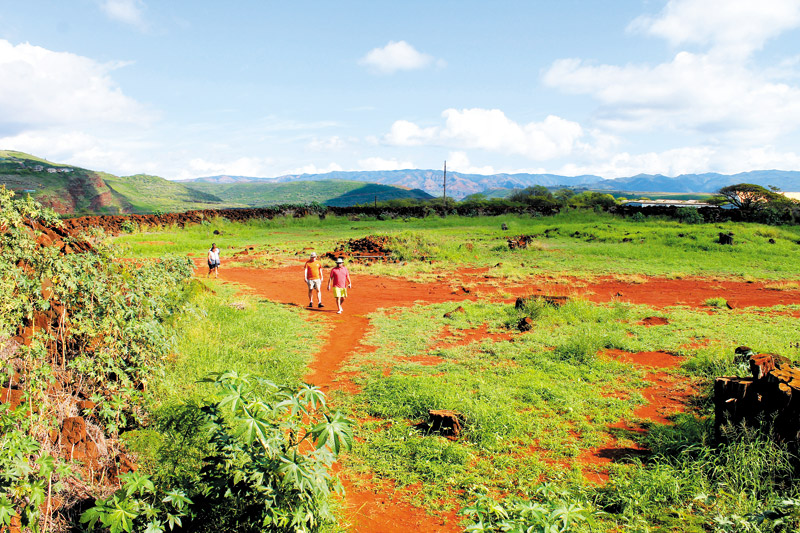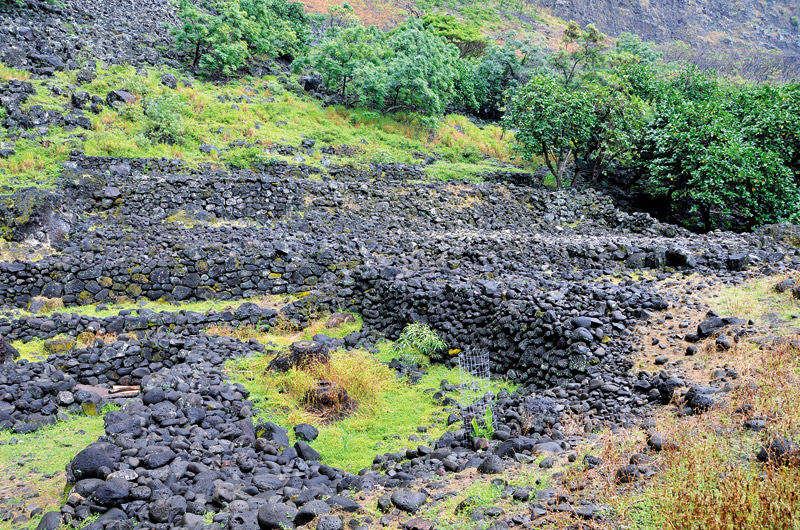The King’s Home
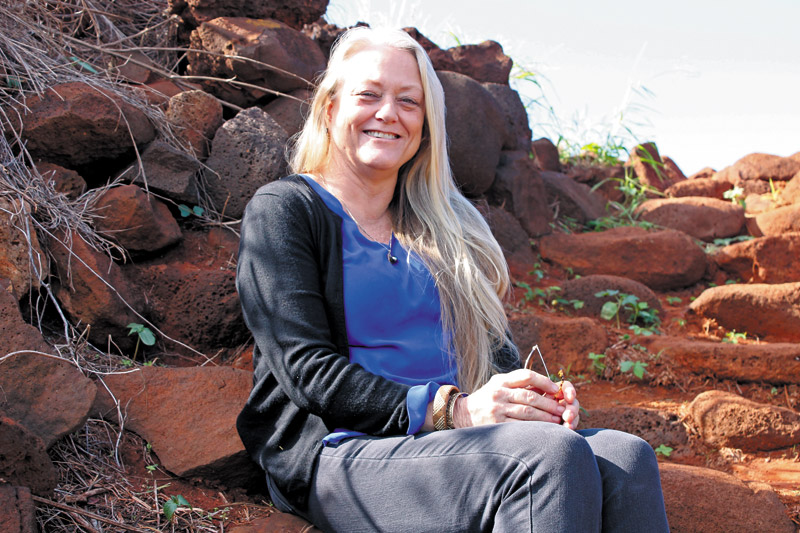
Victoria Wichman on the stairs of the Russian Fort Elisabeth State Historical Park COCO ZICKOS PHOTO
Dried leaves crackle under Victoria Wichman’s shoes as she walks toward the rock stairs at Russian Fort Elisabeth State Historical Park in Waimea. It’s an area steeped in Hawaiian history that she is determined to share and help preserve.
“I wish people would understand the real history of nearly 1,000 years that happened here,” says Wichman, an interpretive program specialist and archaeologist for the state Department of Land and Natural Resources.
Waimea presumably is one of the first places humans settled on the island, and this site happens to be where King Kaumuali‘i and his family lay their heads. It was, accordingly, one of the primary homes of Kauai royalty for hundreds of years, long before the fort was constructed. And, aside from Wailua, it was one of the strongest political centers on the island.
“I think people need to look beyond the sign; beyond the Russian aspect and understand the real history,” says Wichman.
Russians actually had little to do with the area. Russian Fort Elisabeth State Historical Park (also known as Pa‘ula‘ula, Papu o Hipo, or Fort Hipo in archival records) is a misnomer. A German man, Georg Anton Shaffer, conceptualized the 17-acre stretch of land, now maintained by West Kauai Business and Professional Association, which has a stewardship agreement with state parks. The Russian-American Company in Sitka, Alaska, sent him initially to the Islands to pick up shipwrecked cargo. The charlatan ended up befriending Kaumuali‘i and fooling him into believing he had ties to Russia — at the time there was conflict between the Americans, English and Spanish, so Kaumuali‘i yearned to align with Russia. “He (Shaffer) was really an opportunist, an entrepreneur,” says Wichman.
Together, in 1816, they built the first and only structure of its kind in the Pacific, using a mix of European and Hawaiian design. A star-shaped citadel, typically found in Europe, is the dominating feature, and its walls are crafted with heiau stones. The structure served as a Western trading post, where products such as sandalwood were exchanged for other goods.
Kamehameha I soon caught on to Shaffer, however, learning he had no ties to Russia, and promptly warned Kaumuali‘i to banish him.
This is just one of the many stories Wichman has learned throughout her years as an archaeologist and anthropologist in Hawaii. And one of her many roles in the community includes outreach and sharing this knowledge through stewardship groups. Since 1998, for example, she’s worked with Napali Coast Ohana on a restoration project at Nualolo Kai, once a kahua or gathering place. Not only does the all-volunteer group discuss the history of the place when they spend days or even weeks at a time restoring the area, but they also determine the best ways to continue preserving this “wahi pana,” or storied place.
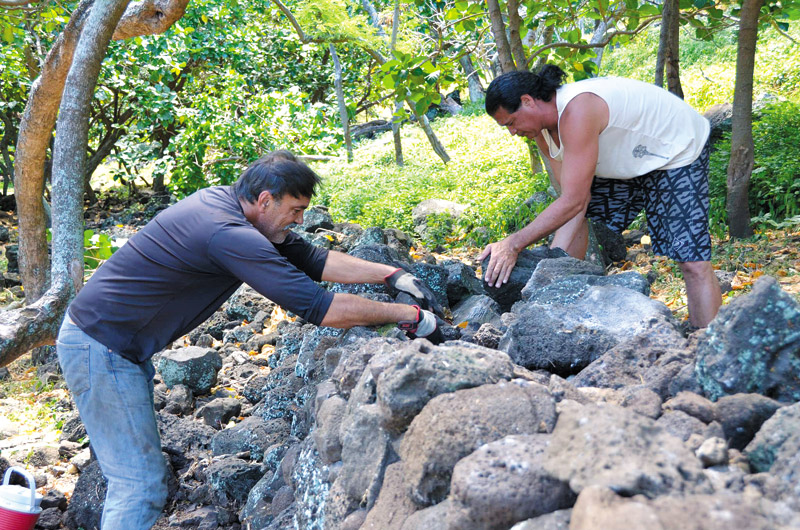
Wichman’s husband, Randy, and Dr. Keao NeSmith restoring the ‘Malama Wall’ in Nualolo Kai
PHOTOS COURTESY OF VICTORIA WICHMAN
She’s married to a fellow historian, Randy, whom she met during a four-month voyage, where they were escorts for three Hawaiian sailing canoes, Hokule‘a, Hawai‘iloa and Makali‘i, as they journeyed to Tahiti and the Marquesas Islands. “We oversaw logistics and safety, and kept track of all the canoe fleet, which were using traditional star navigation,” she says.
Wichman also is involved with seven state park curator and Adopt-A-Park programs around the island, and has worked with groups including Hawaii Youth Conservation Corps.
“They restored my hope in the future,” says Wichman regarding HYCC. In recent years, HYCC volunteers, almost all from Kauai, spent time with Wichman in Miloli‘i in an effort to help restore the valley. “And they have a passion for history; a passion for the past,” she adds. “They want to know; they need to know.”
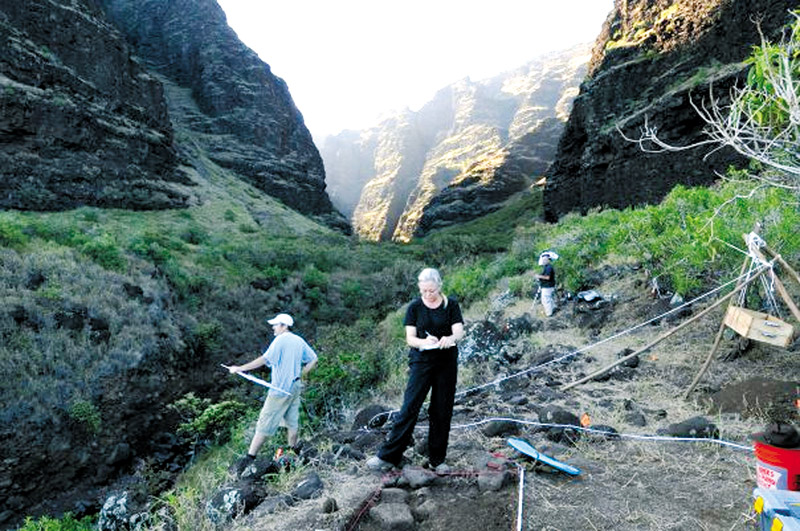
Alan Carpenter, Tim DelaVega and Victoria Wichman working on the Hale Pili site at Miloli‘i, Napali Coast State Wilderness Park. PHOTOS COURTESY OF PATRICK V. KIRCH
She says many keiki don’t even realize where their families come from. One HYCC volunteer, in fact, asked her if she knew his family, who happened to be a part of the community that once lived at Miloli‘i. “A lot of people are looking for a sense of place. By knowing the past of a place, you can know your present and your future,” says Wichman.
Her efforts to preserve the past have not gone by unnoticed.
“I’ve always been in awe of Randy and Victoria Wichman’s commitment to restoring and perpetuating the Hawaiian culture for many years,” says Kauai Visitors Bureau executive director Sue Kanoho, who has worked with Wichman on the Kauai Tourism Strategic Plan as it pertains to Kauai state parks. “I have such great respect for Victoria’s commitment to the Hawaiian culture and her willingness to work with us.”
Wichman’s commitment seems to know no boundaries, as it extends to all places around the island, including those that long have been forgotten, like Russian Fort Elisabeth State Historical Park.
“History will continue. If it doesn’t, as a friend of ours Ke‘eaumoku Kapu said, ‘If we don’t take care of these places and they just continue to turn to rubble, they will all just become a forgotten tale,'” she says. “And I really believe that’s the truth.”


